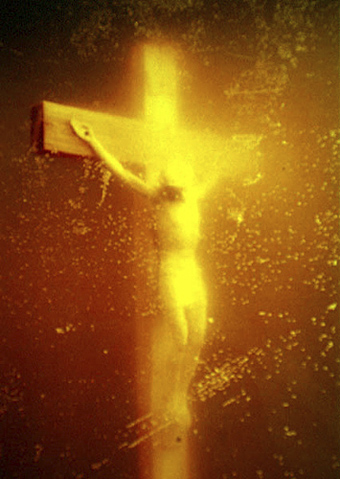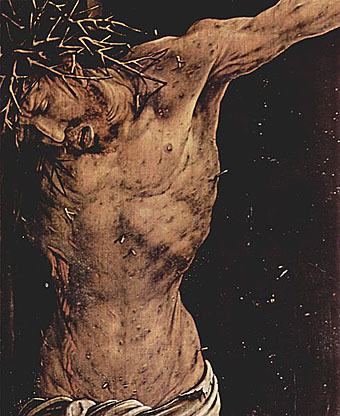
Piss Christ (1987) by Andres Serrano.
If the news of the past few weeks has felt like a re-run of the 1980s—ongoing recession, government cuts, riots in London, Tories casting aspersions on the undeserving poor, the threat of another royal wedding—then add to the list of déjà vu moments a flurry of outrage concerning art and religion in America that’s like a recapitulation of the Helms vs. NEA spats of 1989. On that occasion Andres Serrano’s Piss Christ was in the firing line, accused of being a blasphemous portrayal. This week it’s been the turn of a video installation of a short film made the same year, A Fire in My Belly, by David Wojnarowicz, a work featured in an exhibition I linked to a couple of weeks ago, Hide/Seek: Difference and Desire in American Portraiture at the National Portrait Gallery, Washington DC. A Los Angeles Times piece previewing the exhibition also connected Hide/Seek and the earlier attacks by the right against the NEA, ending by saying “Times and attitudes change”. Well, not always…

A Fire in My Belly (1987) by David Wojnarowicz.
Piss Christ notoriously shows a plastic crucifix immersed in urine; A Fire in My Belly is a 30-minute film which features among its blizzard of images a crucifix besieged by marauding ants. Wojnarowicz’s work wasn’t even mentioned in the LA Times piece but this week’s furore has made it the focus of the entire show after the gallery withdrew the video following protests from the usual suspects, the Catholic League and a right-wing politician, Rep. John Boehner. The complaints are the standard bluster about blasphemy (again) and taxpayers funding “filth”. None of the complainants appear to care that Wojnarowicz’s film is a tribute made by a gay artist to his friends as they were dying from AIDS during the 1980s, a disease which also killed him in 1992, they see the work only as an offensive act. It’s too much to expect anyone reacting with such fervour to consider that the artist may have been comparing the suffering and treatment of people with Aids in that decade with Christ’s suffering on the cross, to do so would be to admit that the artist might have a point. In response to the work’s withdrawal the Transformer Gallery in Washington DC has been screening the film and organised a protest at the National Portrait Gallery. (Update: They also issued an open letter urging the reinstatement of the work.)

left: David Wojnarowicz.
None of the reports I’ve been reading seem aware that the film’s soundtrack is taken from The Divine Punishment (1986) by Diamanda Galás, the first part of her Masque of the Red Death Trilogy in which the plight of people with AIDS is examined through different texts, from Biblical scripture to Decadent poetry to blues and gospel songs. The Divine Punishment has her shouting the strictures against plague victims from Leviticus over a funereal drum-beat which makes it absolutely the right score for Wojnarowicz’s film. One of the Divine Punishment tracks is dedicated to a friend who died of AIDS; Saint of the Pit, the album which followed is dedicated to her brother who died of the same illness. I’d love to hear her opinion of the people who’ve been complaining about Wojnarowicz’s film for the past few days, she never takes any prisoners. (Update: Her response!)
Two ironies are immediately apparent following the withdrawal of the film from the exhibition: the first is that the action has spread news of Wojnarowicz’s work all over the world this week, in which case the Catholic League can congratulate themselves on increasing the viewing of the “blasphemous” film a thousandfold. The second is that the work of both Wojnarowicz and Galás in the 1980s dealt in a forthright manner with the loathing shown towards people with AIDS and the refusal of governments and media to deal honestly and openly with the disease. Among other things Wojnarowicz’s film depicts the artist having his lips sewn together. By shutting out Wojnarowicz from their exhibition the gallery and the Smithsonian Institution re-affirm the point he was making in the 1980s about the voices of the afflicted being silenced.

Detail from the Isenheim Altarpiece (1506–1515) by Matthias Grünewald.
As to the issue of blasphemy, I fail to see any. Boehner and the Catholic League seem unaware of the long tradition in western art of using Christ and saints for their symbolic value, with presentation of the crucified Christ being reworked in order to reflect the concerns of a given audience. One famous example of this is Grünewald’s extraordinary Isenheim Altarpiece, painted for a monastery where people were treated for skin diseases. Christ’s contorted figure is blighted and lacerated, while the pustule-covered creature on one of the St Anthony panels is one of the most grotesque figures in western art.
The problem, as always, is one of interpretation. Dogmatists, authoritarians, fundamentalists, can’t abide the nuance or ambiguity of art despite so much religious discourse concerning itself with questions of interpretation. Piss Christ is regarded as blasphemous not for its appearance but for what the viewer is told about the work by the title. If the same picture had been called Honey Christ without the artist revealing details of the work’s creation no one would ever have bothered with it. As it is, not all Christians found the work blasphemous, art critic Sister Wendy Beckett (a nun) didn’t:
Moyers presses on, asking whether she was offended by Andres Serrano’s Piss Christ, a work which, he claims, “denigrates the central figure of your faith.” Again, she begs to differ. While advancing her opinion that Serrano is “not a very gifted young man, but he’s trying to do his best,” Sister Wendy absolutely refuses to see Piss Christ as blasphemous. Instead she reads it as an admonitory work that attempts to say “this is what we are doing to Christ.”
But then Sister Wendy knows her art history. If Wojnarowicz had really wanted to act blasphemously he could have done far worse than put ants on a crucifix, but blasphemy is the first and only thing being seen when the “wrong” people dare to use Christian imagery. Mel Gibson can thrash Jesus to ribbons (and take a dig at the Jews while he’s about it) and Bill Donohue, president of the Catholic League, is perfectly happy. In fact Donohue took a dig at the Jews himself when defending The Passion of the Christ in a television interview, saying:
Hollywood is controlled by secular Jews who hate Christianity in general and Catholicism in particular. It’s not a secret, OK? And I’m not afraid to say it. That’s why they hate this movie. It’s about Jesus Christ, and it’s about truth. It’s about the Messiah.
Mr. Donohue could learn a thing or two about temperance. The argument against Wojnarowicz is a complaint against a gay man having the temerity to appropriate an icon from his own religious tradition and to use that icon symbolically. It’s unfortunate that a gallery attached to the Smithsonian Institution of all places couldn’t summon the courage to argue as much in favour of the work instead of capitulating to their critics. The Institution is learning now that these people are never satisfied with small victories, they always want more. A peak of philistine hysteria has been reached with another politician, Rep. Jack Kingston, demanding that the Smithsonian have its funding removed. Given the current climate we can expect to hear a lot more about taxpayers’ money funding “obscenity”. Wikipedia tells us that Bill Donohue, who also happens to be the author of Secular Sabotage: How Liberals are Destroying Religion and Culture in America, is paid $343,420 a year for insulting Jews and hounding dead artists. If it’s obscenity you require, look no further than the man’s pay packet.
Update: Hide/Seek: Too shocking for America. One of the exhibition curators speaks out against the censorship.
Previously on { feuilleton }
• Ecce homo
• The art of ejaculation
• Behold the (naked) man
• Giant Skeleton and the Chocolate Jesus
• The Poet and the Pope
• Gay for God
• Michelangelo revisited

John,
as usual, a spot on and brilliant post!
Thank you for a characteristically informed and enlightening perspective on this episode. I was tempted to refer to it as a farce, but it’s too serious for that. These are worrying times.
I wonder about the wisdom of defending works of art against charges of blasphemy. If, absent such a defence, the artist will suffer serious harm, then fine. Otherwise, it seems to leave genuinely blasphemous works of art in the lurch.
Compare with accusations of Jewishness or homosexuality (for example): if not in immediate danger, shouldn’t gentiles and straights let such accusations go undefended?
(And sometimes, of course, solidarity in the face of danger is praiseworthy, too.)
Matthew: What’s at issue here is who “owns” religious imagery, specifically the crucifixion, and who should be allowed to use it in a creative work. I’m ambivalent about that at times, it gives ammunition to people like the egregious Donohue to ban something they otherwise couldn’t touch. However, the Smithsonian could very easily have cited tradition in Wojnarowicz’s favour but for whatever reason (fear about upsetting the new batch of Republicans?) chose not to. As I say above, give these people an inch and they’ll always take a yard.
Regarding the blasphemy quotient of a work, who decides? Bill Donohue, Sister Wendy or Christopher Hitchens? Donohue doesn’t see a sliding scale but an absolute category into which Wojnarowicz’s work belongs.
Nobody owns it, & everyone should be allowed to use it, of course.
You may be right that sometimes one has to get one’s hands dirty and argue about what’s blasphemous and what isn’t. Goes against the grain, though, doesn’t it?
On reflection, it seems to me–but I claim no special expertise–that blasphemy is a kind of impiety, an irreverence directed toward god (not the church–though the law, being practical, differs on this, I think), and that arguments about what is and is not blasphemous can only in good faith be carried out by believers.
As an unbeliever, how can I play the game? It may be that all arguments about what’s pious & what isn’t are nonsense, but even if they are not, how can I join in? Would you want to engage in an argument about how many angels can dance on the head of a pin? How could you?
So: an affront to god is an idea on which I can get no purchase; an affront to the church (or other religious institution) is something I understand, but I don’t see it as wrong.
Make any kind of sense?
These questions are irresolvable since we’re back to interpretation again. I’d define blasphemy as the cheap attempt to trample on something people regard as sacred with offence as the primary motive; that American preacher who wanted to host a Koran-burning recently would qualify. Art rarely stoops to that level since there’s usually another intent at work. Donohue and those who burned The Satanic Verses have a different definition which they apply very broadly and they use that definition as a stick to beat those with whom they disagree. The question should be whether we allow those who see blasphemy everywhere to dictate the terms by which society conducts its business. Christians used to burn at the stake those they disagreed with; we don’t allow them to do that any longer even though the Bible still says “Thou shalt not suffer a witch to live.” Donohue stated this week that he doesn’t visit museums yet by his actions caused a work to be removed from a museum which neither he, nor many of those who agree with him, would have otherwise heard about, let alone seen. They don’t give a damn for the discussion yet want to dictate the terms under which it’s conducted.
The major religions have survived for thousands of years and inspired some of the very greatest art. They look very weak when they have to resort to these bullying tactics.
My last word, because we are, after all, on the same side.
I say let other people have the word “blasphemy”, rather than redefining it to mean something we can all agree is bad, and that we should be able to complete a defence of a “difficult” work of art without tacking on the end “and it is not blasphemous”.
Yeah, I know, minority point of view. ;)
All the best,
m
pustule covered “creature”? that’s a human being you know.
if we all looked at one another with more charitable eyes, the world would be a much better place.
Amelie: Or we could look more closely at what appears before our eyes. That figure has a webbed foot and what may be wings or another webbed foot folded behind it. It’s a corner detail of a panel which shows St Anthony being attacked by a horde of monsters. I used the word “creature” very deliberately because it’s most likely to be a demonic entity.
http://en.wikipedia.org/wiki/Anthony_the_Great#Temptation
The reason that Diamanda Galas’ work, chosen
by David Wojanarowicz as the soundtrack for the
final edit of FIRE IN THE BELLY, was not officially mentioned,
is because the gallery and library which distributed his
work was terrified of Diamanda Galas, inasmuch as she
was never informed of his use of her track.
So they switched the sound for the SMITHSONIAN to an ACT-UP
demonstration.
What they did not count on,however, is that his final
edit had been shown in Rosa von Prauheims film,
SILENCE=DEATH, made in 1989. So the final version,
on YOUTUBE, was the one that the senators and other
vilifiers saw.
This “censorship” issue was FAR more notorious than
most people know. The art world is exceedingly
corrupt, and the art gallery and the estate of several
artists are just as corrupt as the larger galleries,
i.e. THE SMITHSONIAN, and their spokesmen.
Martin Jones